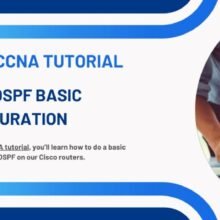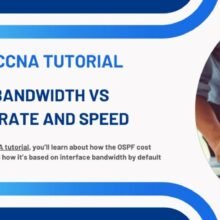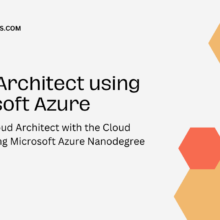Cisco OSPF Basic Configuration In this Cisco CCNA tutorial, you’ll learn how to do a basic configuration of OSPF on our Cisco routers. Scroll down for the video and also text…
Kubernetes for the Absolute Beginners – Hands-on

Learn Kubernetes in simple, easy and fun way with hands-on coding exercises. For beginners in DevOps.
Navigating the Kubernetes Universe: A Hands-on Guide for Absolute Beginners
Introduction: The world of modern application deployment and management has been revolutionized by Kubernetes. For those who are new to this transformative technology, the “Kubernetes for the Absolute Beginners – Hands-on” course on Udemy is your gateway to mastering the complexities of container orchestration. In this in-depth blog post, we’ll explore the course description in detail and uncover the invaluable insights and skills you can acquire on your journey to becoming a Kubernetes aficionado.

- Acquire a Basic Understanding of Kubernetes Fundamentals: Embarking on a journey to master Kubernetes starts with grasping its fundamental concepts. This course takes you through a comprehensive journey, introducing you to key Kubernetes components, terminologies, and the underlying principles that power this container orchestration platform. By building a solid foundation, you’ll gain the confidence needed to navigate more advanced topics with ease.
- Develop Kubernetes Configuration Files in YAML: Configuration is at the heart of Kubernetes management. With the guidance of this course, you’ll learn to craft Kubernetes configuration files using YAML, a human-readable data serialization format. You’ll dive into the intricacies of creating pods, deployments, services, and more, all while harnessing the power of YAML to efficiently define your desired cluster state.
Example YAML Configuration for a Simple Kubernetes Pod:
yamlCopy codeapiVersion: v1
kind: Pod
metadata:
name: my-pod
spec:
containers:
- name: nginx-container
image: nginx
- Deploy a Kubernetes Cluster on Local Systems: Hands-on experience is essential for mastering Kubernetes, and this course ensures you have plenty of it. You’ll learn how to set up a Kubernetes cluster on your local system, allowing you to experiment, practice, and test configurations without the need for cloud resources. This practical approach accelerates your learning curve and fosters a deeper understanding of Kubernetes for Beginners architecture.
- Deploy Kubernetes on Cloud – Google Cloud Platform: Transitioning from a local cluster to a cloud environment is a natural step in your Kubernetes journey. This course guides you through deploying Kubernetes on the Google Cloud Platform (GCP), enabling you to harness the power of cloud resources for your containerized applications. You’ll gain hands-on experience with GCP tools and services while expanding your Kubernetes skill set.
- Deploy Applications on Kubernetes: The true power of Kubernetes lies in its ability to seamlessly deploy and manage applications. You’ll learn how to package your applications into containers, define the desired state of your deployment, and let Kubernetes take care of the rest. This skill is indispensable for ensuring the scalability, availability, and resilience of your applications in a dynamic containerized environment.
- Setup ReplicaSets, Services, and Deployments on Kubernetes: In the realm of Kubernetes, understanding how to manage and control your applications is paramount. This course delves into advanced topics, including creating ReplicaSets for high availability, setting up Services for load balancing and network connectivity, and orchestrating complex application deployments using Deployments. With these skills, you’ll have the tools to manage complex workloads with confidence.

Conclusion: In an era of cloud-native applications and containerization, Kubernetes proficiency has become a highly sought-after skill in the tech industry. The “Kubernetes for the Absolute Beginners – Hands-on” course on Udemy is your passport to unlocking this transformative technology. By enrolling in this course, you’re not only investing in learning – you’re investing in your career.
Whether you’re a developer, an IT professional, or someone looking to stay ahead of the curve, Kubernetes expertise is a game-changer. The comprehensive curriculum, hands-on exercises, and real-world scenarios offered by this course make it an invaluable asset for your professional growth. Embrace the opportunity to become a Kubernetes for Beginners expert, equipped to tackle the challenges of modern application deployment. Enroll today and embark on a journey that will undoubtedly elevate your career to new heights. Your future in the Kubernetes universe awaits – seize it now!
here are 20 multiple-choice practice questions along with their answers to help you prepare for Kubernetes mastery:
Question 1: What is the primary purpose of Kubernetes? A) Container creation B) Cloud-based storage C) Container orchestration D) Virtual machine management
Answer: C) Container orchestration
Question 2: Which file format is commonly used for defining Kubernetes resources such as pods and services? A) JSON B) XML C) YAML D) CSV
Answer: C) YAML
Question 3: What Kubernetes component is responsible for managing the scheduling and placement of containers on nodes? A) Kubelet B) Kube-proxy C) Kube-controller-manager D) Kube-scheduler
Answer: D) Kube-scheduler
Question 4: What Kubernetes resource is the smallest deployable unit in the platform? A) Node B) Cluster C) Pod D) Service
Answer: C) Pod
Question 5: Which Kubernetes object ensures that a specified number of pod replicas are running at any given time? A) Deployment B) StatefulSet C) DaemonSet D) ReplicaSet
Answer: A) Deployment
Question 6: What is a Kubernetes Service used for? A) Load balancing and exposing pods to the network B) Managing data storage in the cluster C) Securing Kubernetes nodes D) Running containerized applications
Answer: A) Load balancing and exposing pods to the network
Question 7: Which Kubernetes resource is used to manage storage volumes that can be shared across multiple pods? A) Pod B) PersistentVolume C) Namespace D) Service
Answer: B) PersistentVolume
Question 8: What is the purpose of a Kubernetes Namespace? A) To isolate nodes in the cluster B) To restrict access to the Kubernetes API C) To organize and partition resources in the cluster D) To manage load balancing for services
Answer: C) To organize and partition resources in the cluster
Question 9: Which Kubernetes networking plugin provides a flat network with full connectivity between pods? A) Calico B) Flannel C) Cilium D) Weave
Answer: B) Flannel
Question 10: What command is commonly used to create a new Kubernetes deployment from a YAML file? A) kubectl create B) kubectl apply C) kubectl deploy D) kubectl generate
Answer: B) kubectl apply
Question 11: What is the purpose of a Kubernetes Ingress resource? A) To manage container logs B) To control pod scaling C) To expose HTTP and HTTPS routes to services D) To define environment variables for pods
Answer: C) To expose HTTP and HTTPS routes to services
Question 12: Which Kubernetes object defines a set of rules for how network traffic is allowed to flow between services? A) NetworkPolicy B) Ingress C) Service D) ConfigMap
Answer: A) NetworkPolicy
Question 13: What is the main role of a Kubernetes ConfigMap? A) To manage persistent storage B) To store sensitive data securely C) To configure environment variables for pods D) To define pod resource limits
Answer: C) To configure environment variables for pods
Question 14: Which Kubernetes component is responsible for exposing the Kubernetes API and handling API requests? A) Kube-proxy B) Kube-controller-manager C) Kube-apiserver D) Kube-scheduler
Answer: C) Kube-apiserver
Question 15: What Kubernetes resource is used to run a command in a container within a pod? A) ExecJob B) ContainerCommand C) PodExec D) ExecPod
Answer: C) PodExec
Question 16: Which Kubernetes command is used to scale the number of replicas in a Deployment? A) kubectl scale B) kubectl resize C) kubectl modify D) kubectl update
Answer: A) kubectl scale
Question 17: What Kubernetes resource is used to manage the deployment of stateful applications requiring stable, unique network identities? A) Deployment B) StatefulSet C) ReplicaSet D) DaemonSet
Answer: B) StatefulSet
Question 18: What is a Kubernetes Secret used for? A) To secure access to the Kubernetes API B) To manage TLS certificates C) To store sensitive data like passwords or tokens D) To authenticate nodes in the cluster
Answer: C) To store sensitive data like passwords or tokens
Question 19: Which Kubernetes resource ensures that a specified number of pods with the same identity are running? A) Deployment B) StatefulSet C) ReplicaSet D) DaemonSet
Answer: D) DaemonSet
Question 20: What is the primary function of a Kubernetes PersistentVolumeClaim (PVC)? A) To create persistent storage volumes B) To request a specific amount of CPU resources for pods C) To manage pod scaling D) To request storage resources for pods
Answer: D) To request storage resources for pods
These practice questions and answers should help you reinforce your understanding of Kubernetes concepts and prepare you for success on your Kubernetes for Beginners journey. Remember to review the explanations for each answer to deepen your knowledge and confidence.








